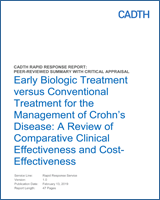| D’Haens 2017, Austria, Belgium, France, Germany, Italy, Netherlands, Spain, Sweden, UK20 | Observational prospective registry study Patients from ENCORE registry, a prospective registry that enrolled from 2003 to 2008 and followed patients for 5 years; patients were eligible when Crohn’s disease treatment (e.g. corticosteroid, immunomodulator, anti-TNF) intensification was indicated; authors identified three groups of patients to compare | n = 2662, ~60% female, 95% Caucasian Age 16 to 86 (median age ~35) with active luminal or fistulizing Crohn’s and no previous exposure to anti-TNF treatment Mean time since diagnosis ~8.5 years; 28% had a fistula in conventional group, 43% in early infliximab group, 27% in switch to infliximab group | Infliximab within 30 days of enrolment visit Conventional therapy: treatment without anti-TNF agents Started with conventional therapy and switched to infliximab during follow up
| Adverse events as reported by the treating physician, assessed every 6 months according to 7 pre-specified categories Safety data were reported as: (1) frequency of all observed adverse events, (2) incidence per 1000 person-years, (3) multivariable analysis by treatment, (4) multivariable analysis accounting for latest infliximab dose relative to onset of adverse events Some analyses were done based on exposure versus non-exposure to infliximab (patients in the step-up group who received infliximab were combined with the early infliximab group); only analyses comparing conventional to early infliximab are reported |
| Fan 2014, China21 | Controlled before-after (prospective study where one group received “top-down” therapy [group 1] and other group [group 2] received corticosteroid then azathioprine in a non-randomized open-label manner) | n=77, 47% male ≥18 years old (median age at onset was 25 years), newly diagnosed with moderate to severe Crohn’s disease and naïve to treatment (median disease duration was 10 weeks) Baseline CDAI score between 220 and 450 (median CDAI 279) with ileal and colonic mucosal ulcerations; excluded if fibrostenotic, fistulizing or penetrating disease | (1) Induction with infliximab 5 mg/kg at 0, 2, 6, 14, 22 and 30 weeks plus azathioprine 1 to 2.5 mg/kg daily from week 6 onwards (titrated to maximum tolerated dose) (2) prednisone 1 mg/kg daily for 7 to 14 days and tapered over 6 to 12 weeks plus AZA 1 to 2.5 mg/kg daily from week 6 onwards (titrated to maximum tolerated dose) | Primary endpoint: deep remission at week 30, 54 and 102 (CDAI score < 150 plus complete absence of mucosal ulcerations observed at baseline) Secondary endpoints: time to clinical remission; clinical remission at week 2, 6, 14, 22, 30, 54, 102; change from baseline for CDEIS score at week 30 and 54; complete endoscopic remission (CDEIS <3); endoscopic remission (CDEIS<6) Adverse events |
| Ghazi 2013, USA19 | Retrospective chart review from the University of Baltimore Inflammatory Bowel Disease Program Charts were reviewed from 2004 to 2010 in patients who were anti-TNF naïve and patients were grouped into two groups: early biologic or step-up | n=93, 59% female Mean age at diagnosis was 28 and mean duration of disease was 11 years 48% of patients had penetrating disease Mean baseline HBI was 3.7 in the step up group and 6.3 in the early biologic group | Early biologic: initial treatment with infliximab 5 mg/kg at week 0, 2, 6 and maintenance every 8 weeks or adalimumab 160 mg at week 0, 80 mg at week 2, then 40 mg every 2 weeks or certolizumab 400 mg at week 0, 2, and 4 then every 4 weeks (the dose interval could be increased or decreased) with or without an immunosuppressant Step-up: immunosuppressant alone or starting an immunosuppressant before an anti-TNF | Response and remission rates (HBI<5), HBI, SIBDQ, steroid free-remission, number of hospitalizations and surgeries at 0, 3, 6 and 12 months after initiation, corticosteroid use |
| Rubin 2012, USA22 | Retrospective cohort study Patients were identified using from an administrative claim database (PharMetrics) between 2000 and 2009 using ICD-9 codes and drug claims; patients had to be continuously enrolled in the same health plan for 6 months prior to their first claim and remain enrolled 12 months after anti-TNF claims; 3 groups were created based on treatment | n=3750, 60% female Median age 40 11% had an anal fistula | Step-up: 5-ASA and/or corticosteroids and/or immunosuppressants prior to anti-TNF “IS-to-TNF”: immunosuppressants only prior to anti-TNF Early-TNF: initiation of anti-TNF within 30 days of first prescription for Crohn’s disease | Concomitant corticosteroid use, Crohn’s disease surgery At 6, 12, 18 and 24 months |
